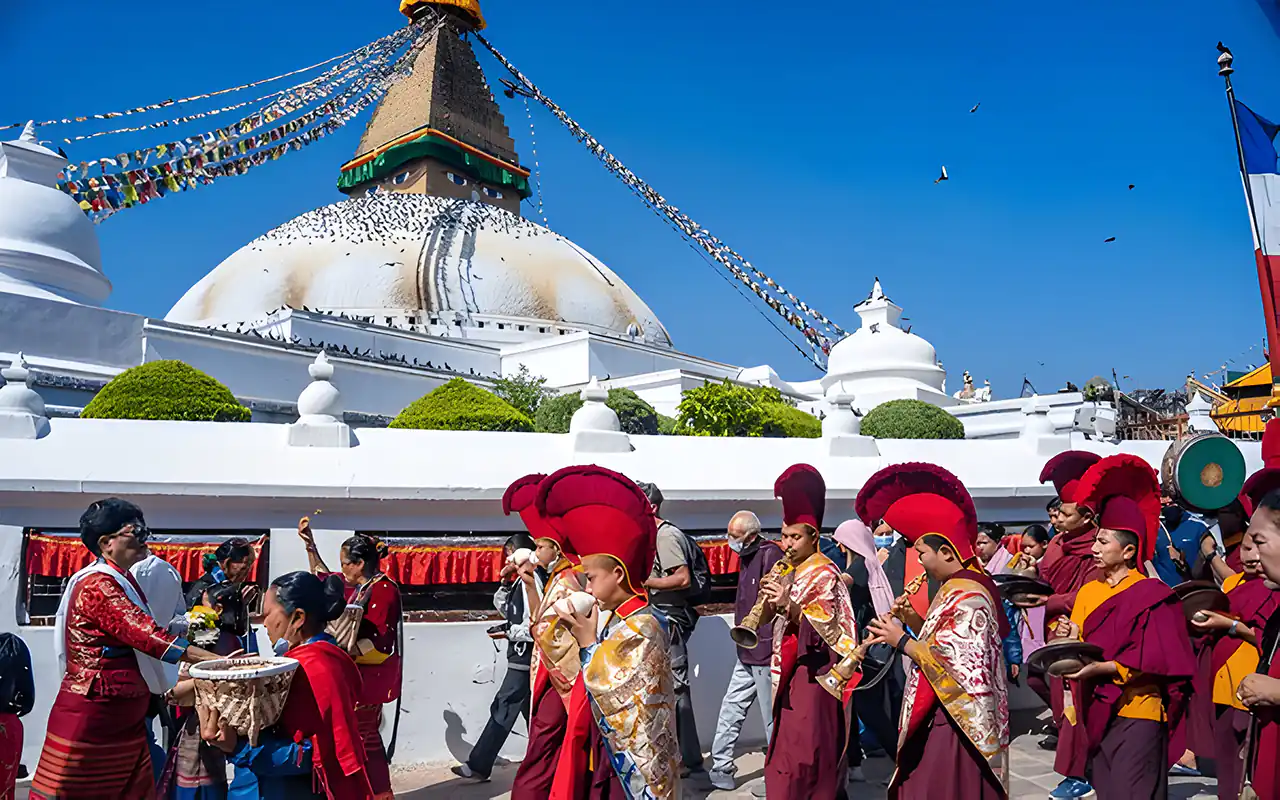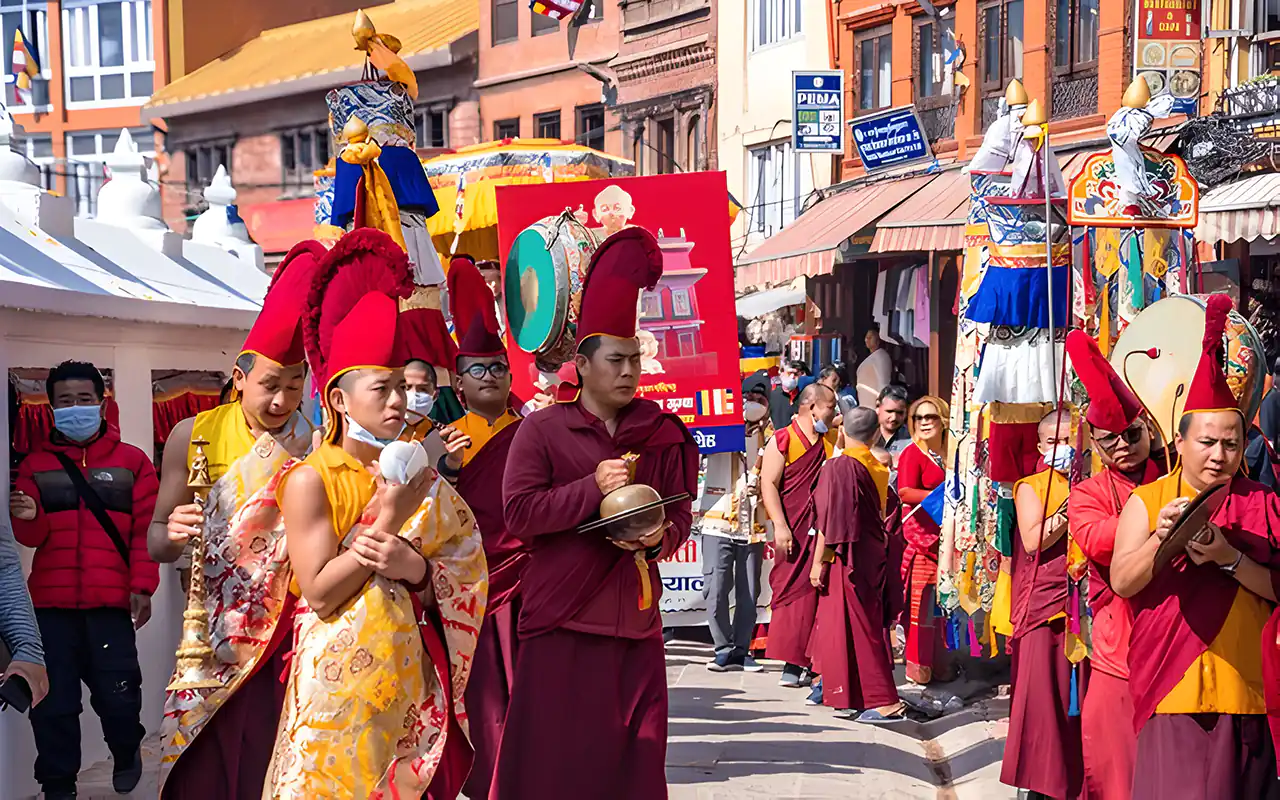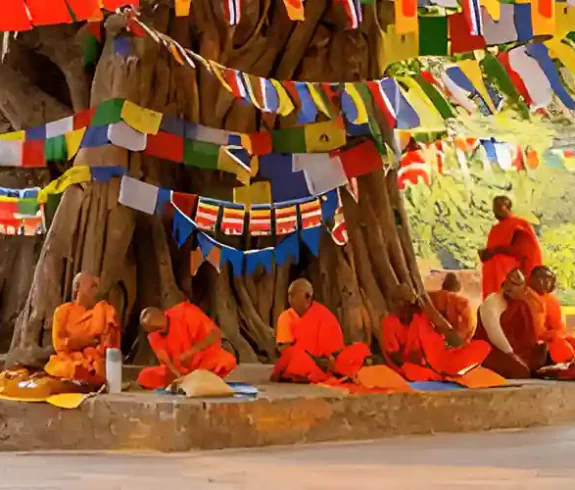Celebrated worldwide, Buddha Jayanti, also known as Buddha Purnima, is a significant Buddhist holiday. It honors the birth, enlightenment, and Parinirvana (final liberation) of Gautama Buddha, the founder of Buddhism. Celebrated on a full moon day in the lunar month of Vaisakha (usually in April or May), this day is a time for reflection, spiritual growth, and acts of kindness.
Understanding Buddha Purnima Meaning
“Buddha Purnima” literally translates to “Full Moon of the Buddha.” This festival holds immense significance for Buddhists as it marks three pivotal events in the life of Gautama Buddha:
- Birth: Prince Siddhartha Gautama, who later became the Buddha, was born in Lumbini, Nepal.
- Enlightenment: Siddhartha Gautama achieved enlightenment under the Bodhi tree in Bodh Gaya, India, transforming into the Buddha.
- Parinirvana: The Buddha passed away in Kushinagar, India, achieving final liberation from the cycle of rebirth.

Gautam Buddha Jayanti: A Day of Reverence
People worldwide celebrate Gautam Buddha Jayani with great enthusiasm and devotion. Buddhists visit temples, offer prayers, and participate in various religious activities.
- Temple Visits & Prayers: The ardent followers of Buddhism make pilgrimages to temples and monasteries to prostrate themselves before the Buddha while praying. Candles, incense sticks, and flowers are in the offering.
- Meditation and Reflection: Many Buddhists meditate and reflect on the teachings of the Buddha, which helps them cultivate mindfulness and inner peace.
- Acts of Kindness: This day encourages acts of compassion and generosity. People donate to charities, volunteer their time, and engage in selfless service.
- Festive Processions: In some regions, colorful processions are organized, featuring floats depicting scenes from the life of the Buddha.
Historical Context: From Prince Siddhartha to the Enlightened One
Buddha Jayanti celebrates the extraordinary life and great lessons of Siddhartha Gautama, the historical Buddha. Prince Siddhartha, born to a royal family in Lumbini, Nepal, lived an early life that was privileged and closed off from the world. However, the misery he witnessed around him moved his heart. This realization propelled him into renouncing all wealth and status in search of truth and emancipation.
After years of dedicated ascetic practices and meditation, Siddhartha achieved enlightenment under the Bodhi tree in Bodh Gaya, India. He became known as the Buddha, meaning “the awakened one.” The Buddha’s teachings primarily focused on the Four Noble Truths and the Eightfold Path, providing a structure for understanding and overcoming suffering.
The Buddha’s Path to Enlightenment
Siddhartha’s journey toward enlightenment involved several pivotal moments:
- The Great Renunciation: Siddhartha left his palace, wife, and newborn son behind to find a way to alleviate human suffering.
- Ascetic Practices: He subjected himself to extreme self-denial and physical hardship but ultimately realized that these practices wouldn’t lead to true liberation.
- The Middle Way: Siddhartha discovered the Middle Way, a balanced path avoiding the extremes of self-indulgence and self-mortification.
- Enlightenment: Siddhartha attained enlightenment and became the Buddha while meditating under the Bodhi tree.
- Sharing the Dharma: The Buddha dedicated the rest of his life to teaching and sharing his insights, laying the foundation of Buddhism.
The Profound Impact of the Buddha’s Teachings
The Buddha’s teachings, or the Dharma, provide a deep understanding of the human experience and a practical path to liberation. His teachings emphasize:
- The Four Noble Truths: These truths shed light on the nature of suffering, its origins, its end, and the way to end it.
- The Eightfold Path: This path of ethical and mental discipline leads to liberation. It comprises correct understanding, correct thought, right speech, proper conduct, right livelihood, right effort, mindfulness, and concentration.
- Impermanence (Anicca): Recognizing that everything is constantly changing and nothing lasts forever.
- Non-self (Anatta): The understanding that there is no permanent, unchanging self or soul.
- Compassion (Karuna): The Buddha’s teachings encourage compassion and mercy for all living beings.

Significance of the Full Moon Day in Vaisakha
Buddha Purnima is strategically celebrated on the full moon day (Purnima) of the Vaisakha month (typically April-May) of the Hindu/Buddhist lunar calendar. This significant date aligns with three pivotal events in Gautama Buddha’s life – his birth, enlightenment (Nirvana), and Parinirvana (passing away).
Astrological and Spiritual Importance
- Whole Moon Symbolism: The full moon is often associated with spiritual awakening and heightened energy. It symbolizes completion, illumination, and the peak of spiritual potential, making it an ideal time to celebrate the Buddha’s life and teachings.
- Vaisakha Month: This month holds particular importance in Buddhist traditions. It’s believed to be when spiritual energies are particularly potent, creating an optimistic backdrop for spiritual practices and celebrations.
- Alignment of Three Events: The alignment of the Buddha’s birth, enlightenment, and Parinirvana on the same lunar date is seen as a divine coincidence, emphasizing their interconnectedness and profound impact on Buddhist philosophy.
Celebrating Buddha Jayanti on this specific date allows Buddhists to
- Honor the Buddha’s life: Pay homage to his extraordinary journey and profound teachings.
- Reflect on his teachings: Contemplate the Four Noble Truths, the Eightfold Path, and other core Buddhist principles.
- Practice mindfulness and meditation: Engage in spiritual practices to cultivate inner peace and wisdom.
- Perform acts of kindness and generosity: Spread compassion and goodwill toward all living beings.
Celebrating with Rituals, Symbolism, and Community
Solemn rituals and joyous community gatherings mark Buddha Purnima. Let’s explore the traditional practices that bring this special day to life.
Rituals and Traditions
- Prayers and Meditation: Buddhists visit temples and monasteries to offer prayers and meditate. The chanting of sutras and mantras fills the air, creating a serene atmosphere.
- Sermons and Teachings: Religious leaders deliver sermons, sharing insights into the Buddha’s teachings and their relevance to contemporary life.
- Observance of Precepts: Many Buddhists observe the Five Precepts more strictly on this day, abstaining from killing, stealing, lying, sexual misconduct, and intoxicants.
- Bathing the Buddha Statue: A central ritual involves cleansing a statue of the baby Buddha with fragrant water to symbolize purity and rebirth.
Symbolic Acts
- Releasing Caged Birds and Animals: This act symbolizes liberation and compassion towards all living beings.
- Offering Incense, Flowers, and Candles: These offerings represent respect and devotion to the Buddha. They also symbolize impermanence, reminding us of the fleeting nature of life.
- Lighting Butter Lamps: Thousands of butter lamps illuminate temples and homes, signifying the light of wisdom and compassion that dispels the darkness of ignorance.
- Decorating with Buddhist Flags: Colorful prayer flags flutter in the wind, carrying blessings and good wishes for all sentient beings.
Community Gatherings
- Processions: Vibrant processions wind through streets, featuring devotees carrying the Buddha’s image, musicians playing traditional instruments, and dancers performing cultural dances.
- Communal Meals: Monasteries and temples often provide free meals to visitors, fostering a sense of community and sharing.
- Acts of Charity: Encourages acts of generosity. People donate to charities, offer food to people in need, and engage in volunteer work.

Regional Variations Celebrations
While it is a highlight of this day, its celebration reflects the diversity in the Buddhist community worldwide. Let’s explore unique local varieties that add color and depth to this exciting event.
Nepal: The Birthplace of the Buddha
- Lumbini Pilgrimage: Devotees flock to Lumbini, the Buddha’s birthplace, to offer prayers and meditate at the sacred Mayadevi Temple and the Ashoka Pillar.
- Monastic Ceremonies: Monasteries conduct special daily prayers, chanting, and meditation sessions.
- Candlelight Processions: In the evening, thousands of devotees participate in candlelight processions, illuminating the streets with devotion and reverence.
India: Land of the Buddha’s Enlightenment
- Bodh Gaya Reverence: Bodh Gaya, the site of the Buddha’s enlightenment, becomes a focal point for pilgrims and spiritual seekers.
- Mahabodhi Temple Offerings: People offer prayers, light incense, and circumambulate the Mahabodhi Temple, a UNESCO World Heritage site.
- Sarnath Teachings: In Sarnath, where the Buddha delivered his first sermon, monks and scholars share insights into the Dharma.
Bhutan: The Land of the Thunder Dragon
- National Holiday: This day is a national holiday in Bhutan, celebrated with great enthusiasm and devotion.
- Temple Visits and Offerings: People visit temples, offer butter lamps, and participate in religious ceremonies.
- Traditional Dances and Music: Colorful masked dances and traditional music performances add a festive touch to the celebrations.
Sri Lanka: Island of Serene Devotion
- Vesak Festival: In Sri Lanka, people celebrate Vesak with elaborate decorations and light displays.
- Dansalas (Free Food Stalls): People set up Dansalas on the streets, offering free food and drinks to passersby and embodying the spirit of generosity and compassion.
- Pandals (Temporary Structures): People build elaborate pandals that depict scenes from the Buddha’s life and showcase Buddhist art and culture.
Cultural and Social Impact of Compassion and Peace
Buddha Jayanti is more than mere ceremonies or celebrations; it is a significant reminder of the Buddha’s teachings, which have significantly impacted societies and individuals.
Teachings Reflected in Celebrations
- Compassion (Karuna): Acts of charity, free food distribution, and animal releases embody the Buddhist principle of compassion towards all sentient beings.
- Peace (Shanti): The serene atmosphere at temples, the emphasis on meditation, and the avoidance of conflict reflect the pursuit of inner and outer peace.
- Non-Violence (Ahimsa): Vegetarianism and the release of captive animals underscore the Buddhist commitment to non-violence and respect for all life forms.
- Generosity (Dana): Offering food, donations, and voluntary service exemplifies the virtue of generosity, an essential aspect of Buddhist practice.
- Mindfulness (Sati): Focusing on meditation and reflective practices encourages mindfulness, cultivating present-moment awareness.
Impact on Societal Norms and Individual Behaviors
These Buddhist values, actively expressed during this day, have a ripple effect on society and individuals:
- Fostering Harmony: Emphasis on compassion, peace, and non-violence promotes social harmony and understanding among diverse groups.
- Encouraging Ethical Conduct: The Five Precepts, particularly emphasized during Buddha Jayanti, enable individuals to lead ethical lives and minimize harm to themselves and others.
- Promoting Mental Well-Being: Mindfulness and meditation offer tools to cope with stress and anxiety and cultivate inner peace.
- Inspiring Social Responsibility: Its compassion and service encourage people to actively contribute to their communities and work towards a fairer world.
- Nurturing Personal Growth: Buddha’s teachings on impermanence and non-self encourage introspection and self-development, leading to greater self-awareness and wisdom.
In the Modern World: Embracing Tradition Through Technology
Although rooted in ancient customs, it is now celebrated in innovative ways thanks to advancements in the modern world. Technology and globalization have transformed how Buddhists connect and commemorate this sacred festival worldwide.
Modern Practices
- Virtual Gatherings and Celebrations: The internet allows individuals to partake in Buddha Jayanti festivities regardless of location. Live-streamed temple ceremonies, virtual meditation sessions, and online gatherings foster a feeling of global community and shared devotion.
- Social Media and Awareness: Social media platforms are abuzz with posts using hashtags like #BuddhaPurnima and #HappyBuddhaJayanti, raising awareness about the festival’s importance. People share inspiring messages, pictures, and videos, encouraging reflection and a sense of connection.
- Digital Offerings and E-Donations: Technology now enables devotees to offer prayers and make donations online, supporting temples and various charitable organizations. This convenient approach not only increases accessibility but also encourages broader participation.
- Learning Resources and Online Courses: Many Buddhist teachings, guided meditation practices, and online courses are readily available. These tools enable individuals to deepen their understanding of the Dharma and apply its principles daily.
Global Influence and Adaptation
Globalization has sparked a cross-cultural exchange of Buddhist practices and traditions. Buddha Jayanti celebrations now exhibit a beautiful blend of local customs and influences from diverse Buddhist communities across the globe.
- Multi-cultural Celebrations: Communities organize events that celebrate the rich tapestry of Buddhist traditions, showcasing music, dance, art, and cuisine from different countries.
- Interfaith Dialogue: Buddha Jayanti acts as a platform for interfaith discussions, nurturing understanding and collaboration between religious groups.
- Environmental Awareness: The Buddha’s teachings on interconnectedness and compassion toward all living beings resonate deeply with modern ecological concerns. Many celebrations now incorporate eco-conscious practices and promote sustainable living.
Navigating Challenges and Embracing New Perspectives
While this day is a joyful celebration and a time for spiritual contemplation, it’s crucial to acknowledge the modern-day challenges and perspectives that influence its observance.
Present-day Challenges
- Commercialization: Like many festivals, Buddha Jayanti faces the pressure of commercialization. The focus can shift from its spiritual essence to consumerism, with excessive decorations, commercial events, and the sale of religious items overshadowing its true meaning.
- Fading Traditions: Current lifestyle and globalization have an impact that can cause the erosion of traditional practices. The younger generation may develop a feeling of disconnection from age-old customs, which may affect the cultural legacy of the festival as a whole.
- Environmental Impact: Large-scale celebrations can sometimes have negative ecological consequences, such as increased waste, noise pollution, and the release of harmful substances.
- Social Inequality: In certain regions, celebrations might not be accessible to all, especially those from marginalized communities, due to financial or social constraints.
Fresh Perspectives and Solutions
- Mindful Consumption: Encouraging mindful consumption during Buddha Jayanti can help counteract commercialization. We should emphasize the spiritual essence of the festival rather than material possessions.
- Preserving Traditions: Community leaders and educational institutions are vital in teaching younger generations about the meaning behind traditional practices and motivating them to participate.
- Sustainable Celebrations: Adopting eco-friendly approaches, such as using biodegradable decorations, minimizing waste, and promoting responsible tourism, helps ensure a more sustainable celebration.
- Inclusivity and Accessibility: Organizing community-led initiatives to ensure celebrations are open to everyone, regardless of socioeconomic status, fosters a stronger sense of unity and belonging.
Conclusion: The Enduring Relevance of Buddha Jayanti
Buddha Jayanti isn’t like another historical day; it’s about a global message centered on peace, compassion, and understanding. Gautama Buddha’s teachings emphasizing the principle of virtuous living are still pertinent today. They direct both individuals and communities inwards to peace and mutual acceptance.
Promoting Peace and Understanding Across Cultures
It isn’t just for one culture or country. Instead, it unites people in various ways to show respect for the Buddha’s knowledge. Teaching us about love, kindness, non-violence, and awareness, known as blissful values, can assist individuals in reconciling their differences and moving most gently in world understanding.
- Peace: At the heart of Buddha Jayanti is the message of peace. By practicing mindfulness and compassion, individuals can cultivate inner peace, which naturally extends to their interactions. Promoting harmony in communities contributes to a more peaceful world.
- Understanding: The global observance of Buddha Jayanti fosters a sense of interconnectedness and mutual respect. People from different cultures come together to honor the teachings of Gautama Buddha, creating opportunities for dialogue and cultural exchange. This shared celebration helps build a foundation of understanding and empathy across cultures.
Wishing you a Happy Buddha Jayanti
As we wish each other a “Happy Buddha Jayanti,” we hope for a more compassionate and peaceful world. The celebration reminds us that Buddha’s teachings inspire positive change, guiding us toward a life of kindness, wisdom, and understanding.
